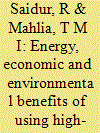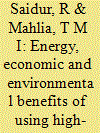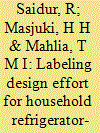| Srl | Item |
| 1 |
ID:
090070


|
|
|
|
|
| Publication |
2009.
|
| Summary/Abstract |
Electric motors are a major energy-consuming appliance in the industrial sector. According to a survey, electric motors account for more than 70% of the total growth from 1991 to 2004 in electricity consumption in this sector in Malaysia. To reduce electricity consumption, Malaysia should consider resetting the minimum energy efficiency standards for electric motors sometime in the coming year. The first step towards adopting energy efficiency standards is the creation of a procedure for testing and rating equipment. An energy test procedure is the technical foundation for all energy efficiency standards, energy labels and other related programs. The test conditions in the test procedure must represent the conditions of the country. This paper presents the process for the selection of an energy test procedure for electric motors in Malaysia based on the country's conditions and requirements. The adoption of test procedures for electric motors internationally by several countries is also discussed in this paper. Even though the paper only discusses the test procedure for electric motors in Malaysia, the methods can be directly applied in other countries without major modifications.
|
|
|
|
|
|
|
|
|
|
|
|
|
|
|
|
| 2 |
ID:
097441


|
|
|
|
|
| Publication |
2010.
|
| Summary/Abstract |
Electric motors use major share (i.e. about 30-80% of total industrial energy consumption) of total industrial energy use around the world. Experiences from other countries show that government intervention in the form of regulations such as mandatory and voluntary approaches can save sizeable amount of energy along with the reduction in emissions associated with energy savings. This paper presents potential energy savings by introducing high-efficiency motors as a case study in Malaysian industrial sector. Emission reductions associated with the energy savings has been estimated and presented as well. It was also estimated that a cumulative amount of 1940 and 892 GWh of energy can be saved for 20 and 120 kW motors, respectively, in Malaysia relative to BAU over the next 10 years. Similarly, a cumulative amount of USD 100 million and USD 60 million can be saved as utility bills for the same motor categories. It has been found that the payback period of different capacities of motors are less than a year. Based on results, it was found that 1789 million kg of CO2 emission can be avoided by replacing standard motors with high-efficiency motors.
|
|
|
|
|
|
|
|
|
|
|
|
|
|
|
|
| 3 |
ID:
097484


|
|
|
|
|
| Publication |
2010.
|
| Summary/Abstract |
Electric motors use major share (i.e. about 30-80% of total industrial energy consumption) of total industrial energy use around the world. Experiences from other countries show that government intervention in the form of regulations such as mandatory and voluntary approaches can save sizeable amount of energy along with the reduction in emissions associated with energy savings. This paper presents potential energy savings by introducing high-efficiency motors as a case study in Malaysian industrial sector. Emission reductions associated with the energy savings has been estimated and presented as well. It was also estimated that a cumulative amount of 1940 and 892 GWh of energy can be saved for 20 and 120 kW motors, respectively, in Malaysia relative to BAU over the next 10 years. Similarly, a cumulative amount of USD 100 million and USD 60 million can be saved as utility bills for the same motor categories. It has been found that the payback period of different capacities of motors are less than a year. Based on results, it was found that 1789 million kg of CO2 emission can be avoided by replacing standard motors with high-efficiency motors.
|
|
|
|
|
|
|
|
|
|
|
|
|
|
|
|
| 4 |
ID:
059439


|
|
|